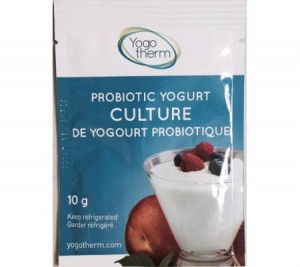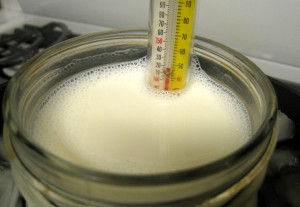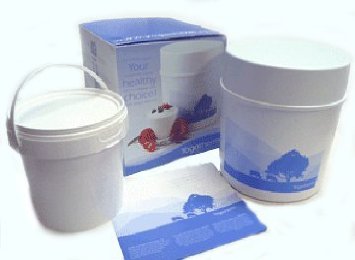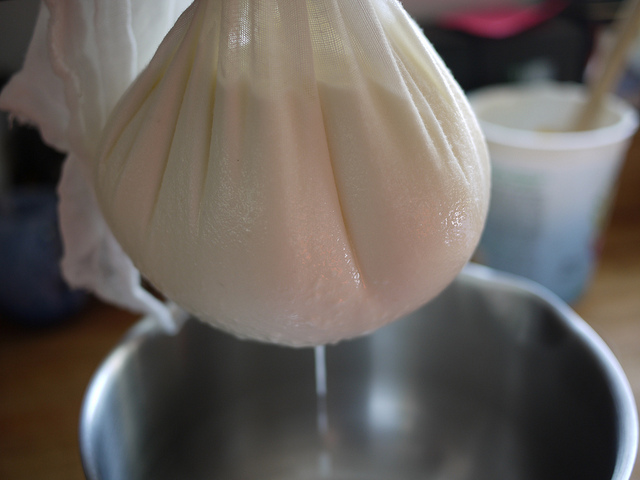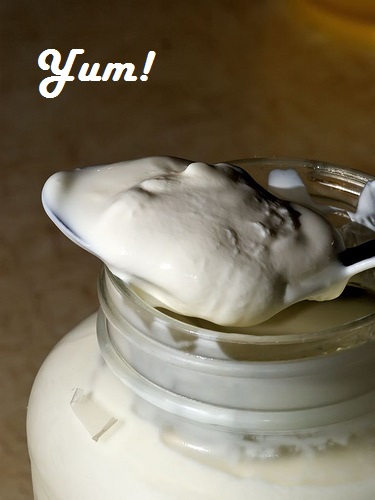Question Do I have to use a new packet of Bulgarian Yogurt Culture every time I make a new batch of yogurt?
Tag Archives: yogurt
Beginner’s Guide to Making Yogurt
If you’ve ever tried looking up the instructions for making yogurt on the Internet, you probably became overwhelmed rather quickly by all the different recipes and techniques. It seems like everyone has their own way of doing it. For a beginner, it can be too confusing to sort out what works best–and to anticipate where things might go wrong!
Fortunately, the Homesteader’s Supply staff has come up with a tried-and-true method for making the creamiest, most delicious yogurt ever! Once you try making yogurt our way using any of our yogurt cultures, you’ll never want to eat store-bought yogurt again.
A Word about Our Yogurt Cultures
We carry a variety of yogurt cultures, including Bulgarian, Italian, and ABY-2C. The main differences between them are in the flavor and the viscosity. Some are more sweet, and some are more tart. Some are thinner, and some are thicker. If you like a very thick yogurt with a mild, sweet flavor, try our Italian culture.
An Overview of the Process
The process of making yogurt comprises five simple steps:
- Heating the milk
- Cooling the milk
- Measuring and adding your chosen yogurt culture
- Incubating the yogurt
- Refrigerating the yogurt until it’s sufficiently cooled to eat
Here’s What You’ll Need
You will need the following:
- 2 liters (or quarts) of your favorite milk (higher fat content yields thicker yogurt)
- dried yogurt culture of your choice (we recommend this one or this one or this one)
- a large stainless steel pot for heating the milk
- a stainless steel thermometer with a long stem (or a candy thermometer, or a digital instant-read thermometer
- a yogurt maker or other improvised setup for incubating the milk (more on this later)
- canning jars or other container for incubating the milk (comes with a yogurt maker, if you have one)
Step 1: Heat Your Milk
- Pour the milk into the stainless steel pot. If using a thermometer that attaches to a pot, making sure the tip of the thermometer isn’t touching the pot. (If using a digital thermometer, follow the manufacturer’s instructions.)
- Gently heat the milk on medium until it reaches 180 degrees Fahrenheit. Then turn off the heat and remove the pot from the burner.
Be careful not to overshoot 180 degrees. It’s better to go slowly rather than to try to turn up the heat too much and then not be able to get the temperature to stop climbing too fast.
Step 2: Cool the Milk
Allow the milk to cool to 115 degrees Fahrenheit. You can do this by allowing the pot to sit on the stovetop (if cool) or counter. Alternatively, immerse the pot in a cold water bath to speed up the cooling process. If you choose to do this, however, be sure monitor the temperature very carefully so the the milk doesn’t cool below 115 degrees!
Yogurt culture is similar to yeast in that the milk needs to be within a certain temperature for the culture to work properly. If the milk is too hot, it will kill the yogurt culture. On the other hand, if the milk falls below 100-115 degrees, the culture won’t get activated.
Step 3: Measure and Add the Dried Yogurt Culture
The amount of dried yogurt culture you need depends on the amount of milk and the type of culture you’re using. For example, in this recipe we are using two liters/quarts of milk, so we can use one envelope of our dried Bulgarian yogurt culture. If you are using a different type of yogurt culture, be sure to read the package directions to determine how much to you need.
Once you’ve measured out the appropriate amount of dried yogurt culture, add it to the cooled milk as described below.
It’s important to mix the yogurt culture in very thoroughly; otherwise, your yogurt might separate. The most reliable method is to start by sprinkling the dried yogurt culture on top of the warmed milk and letting it sit there for a minute or so until it dissolves. When the dried culture has dissolved completely, mix it into the milk. Make sure the culture is distributed evenly throughout. If you start mixing before the dried culture has completely dissolved, it can clump; and then you won’t be able to mix it in thoroughly.
Step 4: Incubate the Yogurt
It’s important to keep your yogurt as close as possible to the ideal temperature of 105 degrees for at least 10 to 12 (or up to 24) hours so the beneficial, health-promoting bacteria in the culture can multiply. This process is called incubating the yogurt. The longer you incubate the yogurt, the fewer carbohydrates it will have because the bacteria feed on the sugars naturally present in the milk. And, a longer incubation period results in thicker yogurt!
This step is easy if you have a Yogotherm or VitaClay yogurt maker. All you have to do is transfer the yogurt into the provided container and follow the manufacturer’s directions.
Things can get a little trickier if you don’t have a yogurt maker, but it’s still relatively easy to set-up your own incubator environment using readily available supplies. Be sure to transfer your yogurt into an appropriate container first! Large Mason jars are a good choice,
We recommend insulating the container of yogurt with towels and placing it in a cooler to keep the heat from escaping. You’ll want to fill any extra air space in the cooler with additional towels (or clean rags) to maximize the insulation. Then, set the cooler in a very warm place.
Ideally, you want to keep the temperature of the yogurt as close to 105 degrees as possible during the incubation period. Under normal conditions, the temperature will drop very slowly over time. It probably won’t fall below 80 degrees, though, and that’s okay.
Step 5: Refrigerate the Yogurt
When the incubation period is over, your yogurt is ready to be refrigerated. If you’re using Mason jars, be careful the temperature doesn’t drop too quickly or the jars might crack.
Allow your yogurt to cool in the refrigerator for at least six hours. During this period, the yogurt will thicken. If the yogurt has separated, you can stir the liquid back in.
For thicker yogurt, you can drain off some of the whey. The easiest way to do this is by using cheese cloth to strain it. You can put the yogurt in cheese cloth and hang it over your kitchen faucet, or suspend it over a bowl and let it drain until the yogurt becomes very thick. If you let most of the whey drain out, you’ll end up with delicious yogurt cheese! Simply scrape the yogurt off the cheese cloth, whip it until it becomes very smooth, and then add herbs, spices, honey, or whatever flavorings you like. Place it in the refrigerator to cool, and in a few hours you’ll have scrumptious yogurt cheese! It’s delightful on crackers, with chips, on sandwiches, etc.
Incidentally, some folks like to thicken yogurt by adding a few tablespoons of powdered milk before heating the milk; however, some experts claim that powdered milk has damaged proteins and recommend avoiding it.
When your yogurt is nice and cool and has reached the desired consistency, it’s ready to eat. You can enjoy it with fruit or whatever flavorings or sweeteners you like.
Q & A: How to Thicken Yogurt
Question: Why do the directions on the package of yogurt culture say to add three tablespoons of dry milk powder to each liter of milk before heating for a firmer yogurt? I’ve noticed that some other recipes give similar advice, too. But, the directions on your website say to use just milk and yogurt culture. In fact, you explicitly state, “No other added ingredients!”
Jerri’s answer: You can add dry milk powder if you want, but there’s no need to. Your yogurt will come out thicker if you incubate it longer.
Yogurt can come out less thick if you don’t thoroughly mix the culture throughout the milk. When that happens, you get a runny layer near the top and thicker yogurt underneath…or even the exact opposite. All you have to do is mix the two layers together and refrigerate, and it will thicken.
One tip for getting a good mix is to sprinkle the dried yogurt culture on top of the warmed milk and let it sit there until it dissolves. This usually only takes about a minute. Then, mix thoroughly. If you start mixing before it dissolves, the dried culture can clump, and then you won’t be able to mix it in thoroughly.
Another reason why your yogurt might not thicken properly is because it didn’t incubate long enough at 105° F. In other words, the temperature decreased too quickly. You need to find a warmer place to keep your incubating yogurt.
And then, of course, using milk with less milk fat, like lowfat 2% milk, will yield a thinner yogurt. The same thing happens with raw milk if the cream has been skimmed off the top.
Q & A: What Kind of Milk to Use for Making Yogurt
Question: I want to use the best quality milk for my yogurt. Can I use raw milk? I’ve heard it’s a lot healthier than regular, store-bought milk.
Jerri’s answer: The main reason why raw milk so healthy is because of all the enzymes it contains. The very best raw milk comes from organic, grass-fed cows and has the most enzymes.
Individual enzymes have different functions. For example, lactase and amylase break down the sugars and other carbohydrates in raw milk, making it easier to digest. Phosphatase releases the phosphorus your body needs to absorb the calcium. Lactoperoxidase forms an anti-microbial complex that helps prevent pathogens from growing in raw milk. And lipase breaks down fat. Raw milk also contains catalase, which aids in cellular waste management.
All these beneficial enzymes are destroyed when milk is pasteurized. Milk is heated to the appropriate temperature for the type of pasteurization process being used. Ultra-pasteurization is the most common method. This process heats milk to 280° F for two seconds. Traditional pasteurization takes less heat and more time. Even so, milk is heated to a minimum of 161° F.
When making yogurt, you need to sterilize the milk by heating it to 165-180° F. This kills all the bacteria, both good and bad. That way, when you add the yogurt culture, you are culturing your milk with specific lacto-bacteria. That’s why our yogurt comes out the same every time. Many folks use raw milk for yogurt and heat it to only 105-115° F before adding the culture. Sure, some other types of lacto-bacteria are probably present, but your yogurt will most likely turn out ok, or even good. Usually, with yogurt, no matter what type of milk you use, the enzymes will be gone when you heat it to 160° F or higher; but, hopefully, the beneficial bacteria will compensate. Some folks with lactose intolerance cannot tolerate yogurt–even when made from raw milk that has been heated to 160° F. People just have to try and see what works for them.
So, for the best quality yogurt, use organic milk from grass-fed cows. It’s up to you if you want to use raw milk or milk that has been pasteurized. Whether you use cream-top or homogenized milk is also a matter of personal preference.


